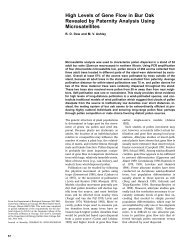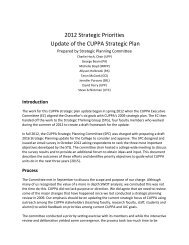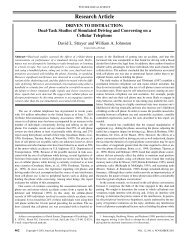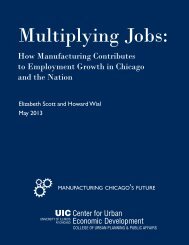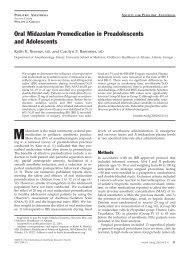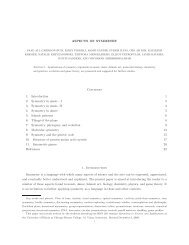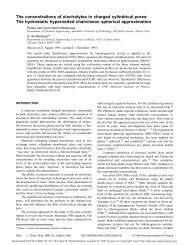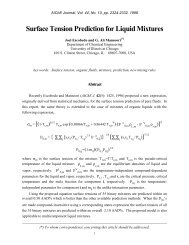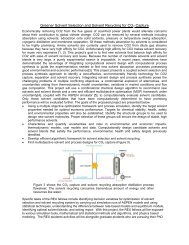Structure & Properties of Micelles and Micelle Coacervates of ...
Structure & Properties of Micelles and Micelle Coacervates of ...
Structure & Properties of Micelles and Micelle Coacervates of ...
Create successful ePaper yourself
Turn your PDF publications into a flip-book with our unique Google optimized e-Paper software.
(MCP) <strong>of</strong> asphaltene. In what follows an accurate <strong>and</strong> reliable technique for measurement <strong>of</strong> micellization <strong>and</strong><br />
coacervation <strong>of</strong> asphaltene in pure solvents is reported <strong>and</strong> a number <strong>of</strong> representative measurements are made.<br />
EXPERIMANTAL PROCEDURE<br />
The experimental method proposed by Escobedo <strong>and</strong> Mansoori (1995 & 1997) to determine the onset <strong>of</strong><br />
asphaltene steric-colloid formation in petroleum through viscometry is proven to be equally applicable for the<br />
detection <strong>of</strong> asphaltene micelle formation in polar solvents. In the present study the phase diagram <strong>of</strong> asphaltene<br />
micellization <strong>and</strong> micelle coacervation in polar-organic solvents (1-methyl naphthalene) is investigated in the<br />
temperature range <strong>of</strong> 0-160 o C using the viscometry method.<br />
Two ranges <strong>of</strong> concentrations were used in this investigation; The low concentration range <strong>of</strong> 0.1-1.0 mg/g<br />
asphaltene in solvent. The high concentration range <strong>of</strong> 1-10 mg/g asphaltene in solvent. 1-methyl naphthalene was<br />
chosen as the solvent. The solutions were aged for 24 hours before measurement. This method is based on<br />
observations <strong>of</strong> the trend in the relative viscosity variations with increase in the concentration <strong>of</strong> asphaltene in a<br />
solvent. The points <strong>of</strong> inflection on plots <strong>of</strong> relative viscosity vs. concentration <strong>of</strong> asphaltene in 1-methyl naphthalene<br />
at various temperatures, corresponding to the critical micelle concentration (CMC) <strong>and</strong> micelle coacervation points<br />
(MCP), were determined. In this study we also have produced, both, lower <strong>and</strong> upper limits to micellization (CMC<br />
<strong>and</strong> micelle saturation points) as well as lower <strong>and</strong> upper limits to micelle coacervation (MCP <strong>and</strong> phase separation)<br />
which was never done before for asphaltene.<br />
The asphaltenes used in this study were two different kinds, Arabian medium heavy resid (AMHR)<br />
asphaltene obtained from Texaco Corp. <strong>and</strong> pentane-insoluble bitumen fraction (PIBF) asphaltene obtained from<br />
Syncrude in Canada. The 1-methyl naphthalene used in this study was produced by Aldrich Chemical Company,<br />
catalog no. M5,680-8 [90-12-0], 95% pure, BP. 240-243 o C, MP. -22 o C. The experiments were run at constant<br />
temperatures <strong>of</strong> 0-160 o C with increments <strong>of</strong> 10 o C for asphaltene in 1-methyl naphthalene (below boiling point <strong>of</strong> 1-<br />
methyl naphthalene). The solution viscosity was measured using glass capillary viscometer (Cannon-Fenske-Opaque)<br />
manufactured <strong>and</strong> calibrated by Industrial Research Glassware Ltd. for which calibration certificate was provided<br />
with the instrument. Two different viscometers, R14 <strong>and</strong> R15, were used to cover the viscosity ranges <strong>of</strong> all<br />
concentration <strong>of</strong> dilutions (low <strong>and</strong> high concentration). The viscometer constants were verified for accuracy using<br />
distilled water known viscosity data. Kinematics viscosities are based on the value for water adopted by the National<br />
Institute <strong>of</strong> St<strong>and</strong>ards <strong>and</strong> Technology <strong>and</strong> the American Society for Testing <strong>and</strong> Materials July 1, 1953. The<br />
kinematics viscosity basis is 1.0038 mm 2 /s (cSt) for water at 20 o C. The gravitational constant, g, is 980.1 cm/sec 2 at<br />
the Cannon Instrument Company. The gravitational constant varies up to 0.1% in the United States.<br />
Each kinematic viscosity point <strong>of</strong> asphaltene in 1-methyl naphthalene were measured three times to ensure<br />
the reproducibility <strong>of</strong> the data. Enough time was allowed for the dilution in each sample to reach thermal equilibrium<br />
(Escobedo <strong>and</strong> Mansoori, 1994 & 1997) before measurement was made. The equilibration time was determined<br />
experimentally based on samples in which asphaltene dilution had already occurred <strong>and</strong> no variation in the viscosity.<br />
During the determination <strong>of</strong> the equilibration time, the open end <strong>of</strong> the cuvette cell was capped to prevent solvent<br />
evaporation.<br />
6



